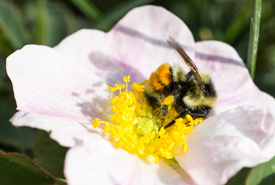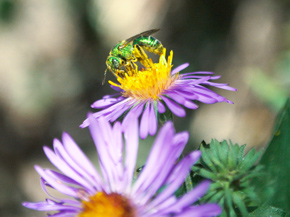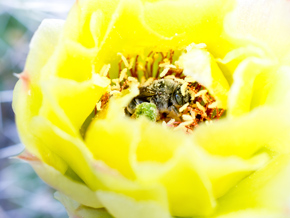Protecting our pollinators: From small seeds to large landscapes
Steps we can take to conserve our incredible native bees
Bumblebee on rose (Photo by Sean Feagan/NCC staff)
Alberta’s native bee species, essential pollinators to both ecosystems and agriculture, need our help.
Beyond bumble bees
When many people consider bees, they think of the ubiquitous honey bee (an introduced, domesticated species) or those buzzing bumble bees.
But those two groups comprise only a small portion of the over 300 bee species found in the province, explains Megan Evans, Alberta Native Bee Council president.
“Bees are an incredibly diverse group,” says Megan. “There are twice the number of bee species here than all the mammal, fish, amphibian and reptile species in the province combined.”
Unlike colony-forming honey bees and bumble bees, many native bees are solitary, meaning they forage, nest and reproduce on their own — without the help of workers.
Alberta’s native bees vary remarkably in appearance, coming in many shapes, sizes and colours.
“Some of them are teeny tiny, while some are big, like the bumble bees,” says Megan. “There are red bees, blue bees, black bees and green bees — you name it.”
They also vary by where and how they nest and what flowers they seek. Some are generalists, feeding on many different flowers, while others are specialists, with a much narrower palate.

Green metallic bee foraging on aster (Photo by Sean Feagan / NCC staff)
Why diversity matters
“Diversity is nature’s insurance policy,” says Megan.
Agricultural areas with more native bees are often less reliant on managed honeybees, which suffered high losses this winter.
“This shows the importance of maintaining and sustaining healthy and resilient native pollinator populations,” she says. “Bees pollinate not only crops, but also native plants that provide food and habitat for wildlife, and those are the foundations of terrestrial ecosystems.”
Despite their importance, there is evidence that some native bee species are declining due to habitat loss, among other pressures.
How to help our bees
There are several steps we can take to help our native bees.
It starts in the yard
The first step can be taken in our own backyards.
“If you can plant native flowers, that is the simplest, single best thing you can do to help native bees,” says Megan.
The Alberta Native Bee Council offers a list of 12 native plant species that not only provide food for bees but also look great in the garden.
Conserve land, conserve bees
The next step in helping bees is conserving larger areas of bee habitat, including intact, natural landscapes.
“Protecting the natural systems we have is really important for native bees,” says Megan. “Bees need food and nesting resources, and native ecosystems naturally provide those things.”
While some bee species can tolerate some land alteration, others are not so lucky — especially the specialists that forage on only a single plant species or plant group, says Megan.
For example, one such specialist in Alberta is the common harebell sweat bee, a specialist of common harebell.
“What happens when you have plowed over a field and removed all the common harebell? says Megan. “You are going to lose that bee.”
Donate to the Nature Conservancy of Canada today to help to protect these areas, including prairie grasslands

Native bee foraging in cactus flower (Photo by Sean Feagan/NCC staff)
Filling data gaps
Scientists have documented population declines in some native bee species. But for many, there is not enough data to tell which way their population is heading.
Another way to help bees is by helping close these data gaps by documenting the bees seen around you. By downloading the iNturalist app or by participating in Bumble Bee Watch, you can upload and share your images with scientists around the world.
Learn more at upcoming events
To help introduce Albertans to the fascinating world of our native bees and celebrate World Bee Day on May 20, NCC is hosting upcoming field events with bee experts. Come out to learn more about our native pollinators!





